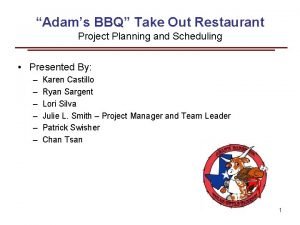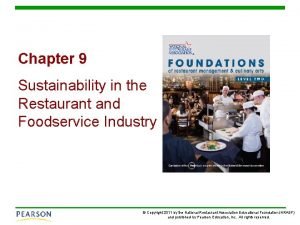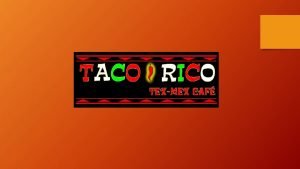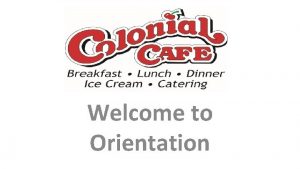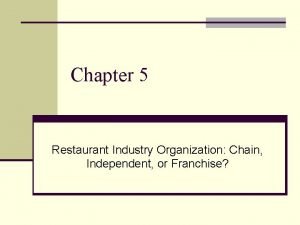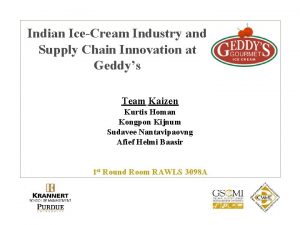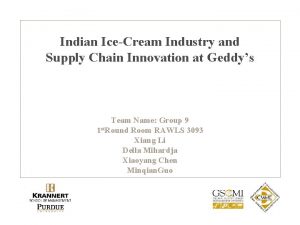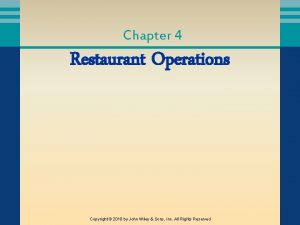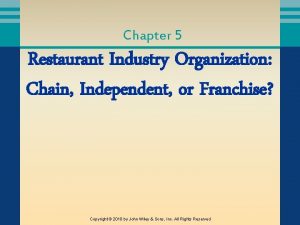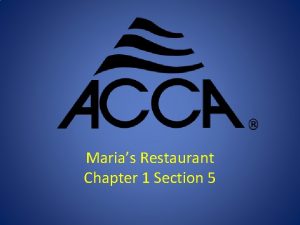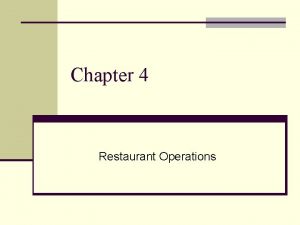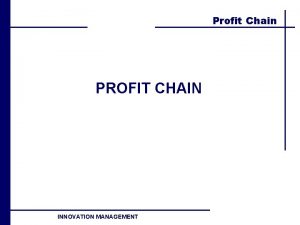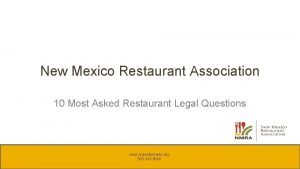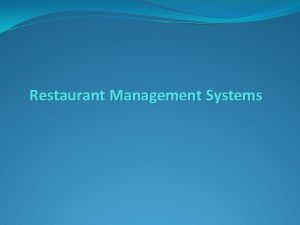Chapter 5 Restaurant Industry Organization Chain Independent or




















- Slides: 20

Chapter 5 Restaurant Industry Organization: Chain, Independent, or Franchise?

RESTAURANT INDUSTRY ORGANIZATION n This chapter will focus on restaurant company organization – that is, how companies are organized n This is important to know because there are significant differences between chains (corporate), independents and franchises n Currently, the industry growth is being driven by chains so we will start with them

LARGEST CHAINS 1. 2. 3. 4. 5. Mc. Donald’s KFC Burger King Starbucks Subway 6. 7. 8. 9. 10. Pizza Hut Wendys Taco Bell Dominos Dunkin Donuts

CHAINS Chains have strengths in 7 areas: n Marketing and brand recognition n Site selection n Access to capital n Purchasing economies n Centrally administered control and information systems n New product development and n Human resource development

CHAINS Marketing and Brand Recognition n Chains are able to achieve a high level of brand recognition by keeping their messages simple, large marketing budgets and the additive effect (repeating the message) n The large cost of the marketing a national company is spread among a large number of units

CHAINS Site Selection Expertise n Much of a restaurant’s success is owed to choosing the proper site n It has become much more competitive to identify suitable sites n Choices are based upon a thorough examination of the feasibility of the site

CHAINS Access to Capital n This can be a challenge because of the rising costs of opening a restaurant coupled with lenders’ view that the restaurant business is risky n Options include loans from banks, friends and family, personal savings, limited investors, “going public”

CHAINS Purchasing Economies n The power of purchasing large quantities for distribution among different locations or, entering into a contract with a company for multiple individual purchases n When one considers that food is a primary expense, the savings of 1% – 2% can be significant

CHAINS Control and Information Systems n Chains can also afford to purchase expensive systems with the justification that the cost will be spread across multiple units n Contrast this with the challenge of an individual operator purchasing a system beyond his or her means.

CHAINS New Product Development n This is only becoming more important as competition increases n Large chains can afford to staff and equip development kitchens

CHAINS Human Resource Program Development n Again, the cost of recruiting, hiring, training and developing is spread across multiple units n Also, Human Resource expertise can be centralized n There can also be disadvantages

CHAINS n Largely as a result these strengths, chain domination (as measured by market share) has grown over the last several years n The top 100 chains alone generate over 50% of all restaurant sales n This domination has increased from just 33% in 1975

INDEPENDENT RESTAURANTS n It is one thing to look at the chain domination, however, looking at it the other way, independents generate a significant portion of sales as well n While chains have strengths that allow them to grow and maintain profit margins, independents have their own advantages

INDEPENDENT RESTAURANTS n Operating advantages n Flexibility n Marketing and brand recognition n Unique advantages in local markets n Site selection n Knowledge of area n Access to capital n Unique advantages in local markets

INDEPENDENT RESTAURANTS n Purchasing economies n Advantages and disadvantages n Control and information systems n Lack of centralized system but ability to track first hand n Human resources n Lack of advancement opportunities but other advantages n Flexibility n Differentiation

FRANCHISED RESTAURANTS n Franchising is a common business format n Franchises represent a $1. 5 trillion “industry” – others besides food service n Business format franchising allows individuals to operate a business under clearly specified guidelines n Guidelines include systems and standards of operation

FRANCHISED RESTAURANTS n The relationship between the franchisor and the franchisee are dictated by the Franchise Agreement n Franchise agreements include use of trademarks, location, terms, fees, obligations and duties of both parties, restrictions and renewal and termination of the agreement

WHAT DO FRANCHISORS OFFER? n Operating and control procedures n Food portioning n Information management n Reliable and timely information n Quality control n Via inspections n Training materials and trainers n Field support

WHAT DO FRANCHISORS OFFER? n Purchasing n Co-ops or approved suppliers n Marketing n Established marketing programs n Advertising n National programs n New products n New concepts

ADVANTAGES AND DISADVANTAGES n Advantages, disadvantages for franchisees n Advantages and disadvantages for franchisors
 Scope of restaurant project
Scope of restaurant project Eltonian pyramid
Eltonian pyramid Sustainability in the restaurant and foodservice industry
Sustainability in the restaurant and foodservice industry How more can restaurant industry
How more can restaurant industry Taco rico tex mex cafe
Taco rico tex mex cafe Chain of command restaurant
Chain of command restaurant Independent clause fanboys independent clause
Independent clause fanboys independent clause What is ad agency definition
What is ad agency definition Firm behavior and industry organization
Firm behavior and industry organization Firm behavior and the organization of industry
Firm behavior and the organization of industry Referral group hotel adalah
Referral group hotel adalah Difference between chain and independent restaurants
Difference between chain and independent restaurants Ice cream value chain
Ice cream value chain Ice cream supply chain
Ice cream supply chain Process organization in computer organization
Process organization in computer organization Block organization essay- examples
Block organization essay- examples Chapter 7 restaurant
Chapter 7 restaurant Chapter 4 restaurant
Chapter 4 restaurant Chapter 3 restaurant
Chapter 3 restaurant Supply chain organization chart
Supply chain organization chart Cause and effect introduction
Cause and effect introduction
